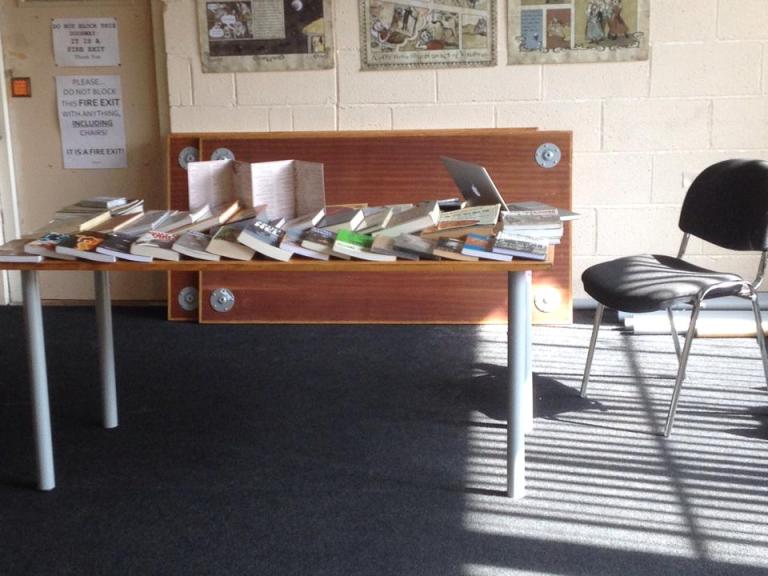So, ‘Spring-Heeled Jack in Everton’ was over, and so were the patchy mid-summer downpours (I wished that they were April showers, but August’s not that versatile…) – so, going by the original plan, my time with Hope Street was over, right?
Not quite – see, I’d enjoyed myself so much that I ended up asking if I could stay on for the rest of the project. There was a bit of humming and hawing, but our producers John and Montse eventually relented and I was belatedly welcomed to the programme full-time. And, after a day or two of catching up on business matters and the like, we were straight into our next project – ‘Race Against Time’, an immersive theatrical game directed by Adam McGuigan of Zambia’s Barefeet Theatre.
At this point, I was to discover that the four weeks we had been given to make ‘Spring-Heeled Jack’ were a veritable luxury – here, we had just three weeks to pull together a show that required participants to run around the city, visiting various landmarks and unpicking fragments of the story. Fortunately, Adam had his head screwed on and knew exactly what he wanted of everyone.
Well, everyone except one guy.
Yep, Sunny Jim here hadn’t been at the R&D, so Adam had no idea I even existed until the first day of rehearsals when he was essentially told “Guess what – we got you a researcher! Happy Christmas”. To his credit, he made an effort to include me and to utilise my skills to the best of my abilities, but by the end of the first week I was beginning to feel disenchanted, useless, and pondering whether I might have made a mistake in carrying on. I feel at pains to point out this wasn’t Adam’s fault – I enjoyed working with him, and it was delightful to see the way my fellow EAPs gelled on this project. There just didn’t seem to be space in it for the little niche I’d expected to fill.
As it happened, my niche was in a different area entirely. We had originally had two stage managers, but one of them had vanished before I even started on ‘Spring-Heeled Jack’, and Christos was still in South Wales. Fortunately, we found the equally heroic Ellie to join us, and were joined for this project by the eminently capable Sonia and Kate, but ‘Race Against Time’ was a very production-heavy show, and it was very much a case of ‘all hands on deck’.
As the first week melded into the second, Adam’s tasks for me were moving away from pure research and into more production-based matters. By Wednesday of the second week, I was liaising directly with our production manager, Sian. I was hardly doing complex stuff, but I was being useful – tracking down stopwatches, finding a red carpet, getting quotes for stretch limousines – and it was a nice way to polish up some skills I’d never been all that good at.
Also, I got asked to do acting. Glory in my wooden generAmerican accent. And while you’re at it, check out the lovely folks at Draw&Code, who worked wonders with the multitudinous audio-visual elements we demanded of them.
And so to show week, where alongside my roles of cold-calling various businesses to beg for things and aggravating Sian, I was once again called upon to provide music for the evening. Nothing quite so arduous as last time; Luke had once again written some delightful music (seriously, is there any genre that boy can’t compose in?), and I just had to make sure I played the right notes. There were a few moments of stress – not being able to find a bass player, for one – and we did have to cheat slightly on strict historical accuracy when it came to the guitar (a subject on which I could go on for hours, and you should be glad I’m not), but come Saturday we were set. We had an hour’s worth of playing at the delightful Liverpool Medical Institute, just around the corner from Hope Street Ltd and the birthplace of one of my heroes, William Roscoe; then, while the rest of the company were dashing round the city centre, dressing venues, resetting scenes and getting out, we adjoined to the aftershow venue over the road and had a very comfortable few hours eating, drinking and commenting on Mark Reckless’ defection to UKIP.
For some reason, when it came to the actual aftershow I decided to improvise my own character – the bandleader Edwin Costello, from Tupelo, Kansas. I even ended up doing a rendition of ‘Cry Me A River’ (the Julie London version, not Justin Timberlake’s). And then I drank a lot of whiskey, we all went to Magnet, I met Lee Mavers, and we made Adam cry. It was a good night.
And, just like that, it all changed. We had one more project to go, but there would be no lead artists, no mentors, and no pre-formed vision. It was time for us to put all we’d learned to use, and show what good the last few months had done…




